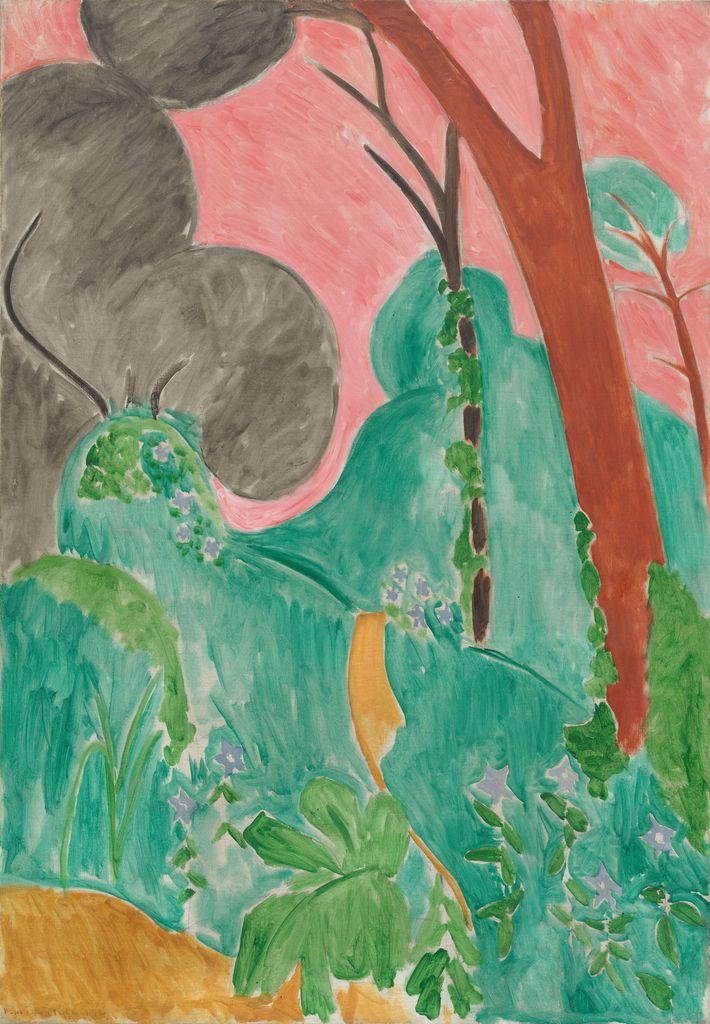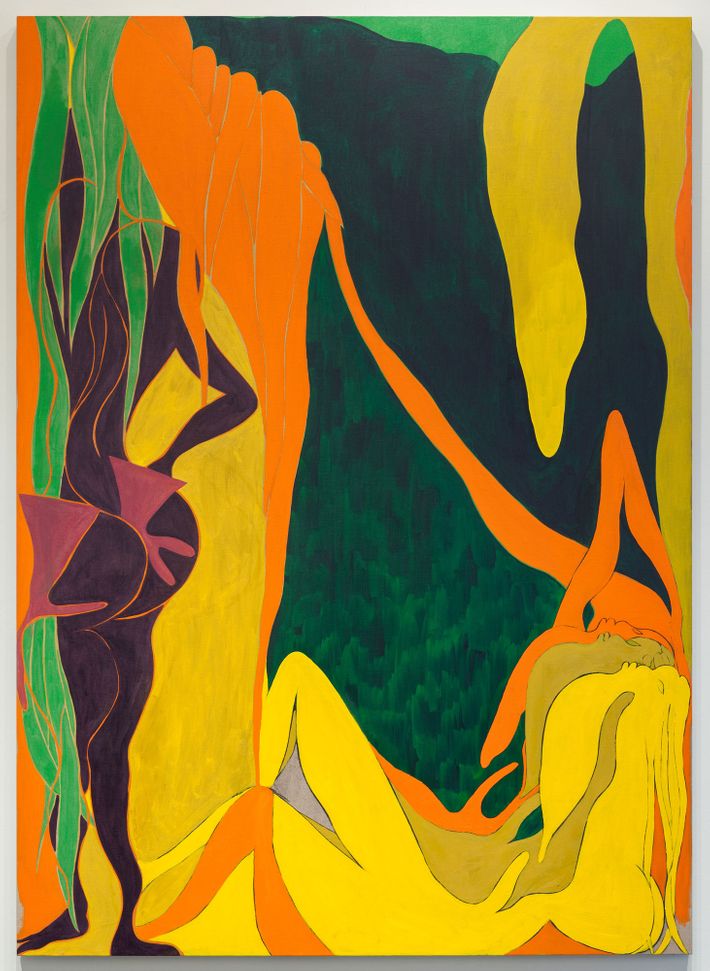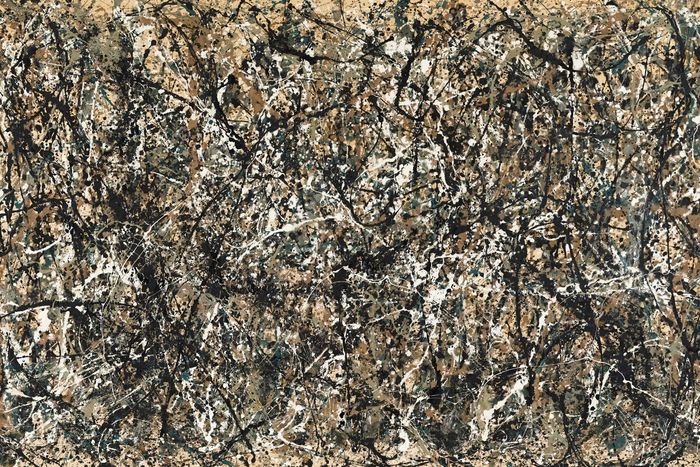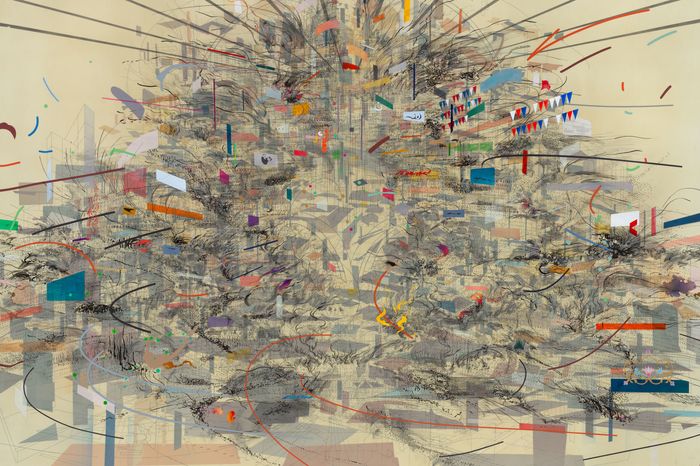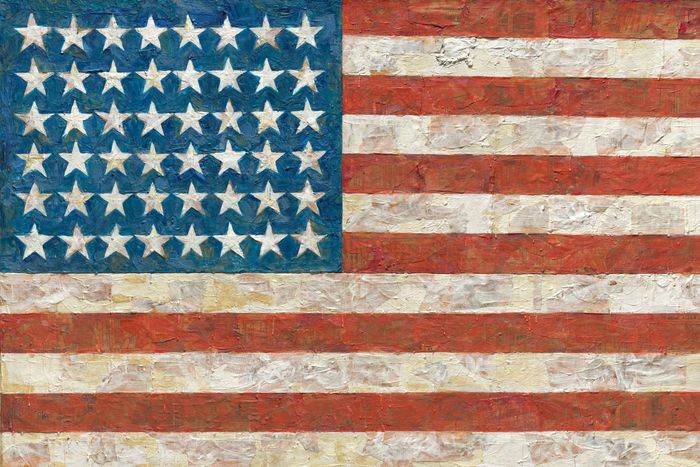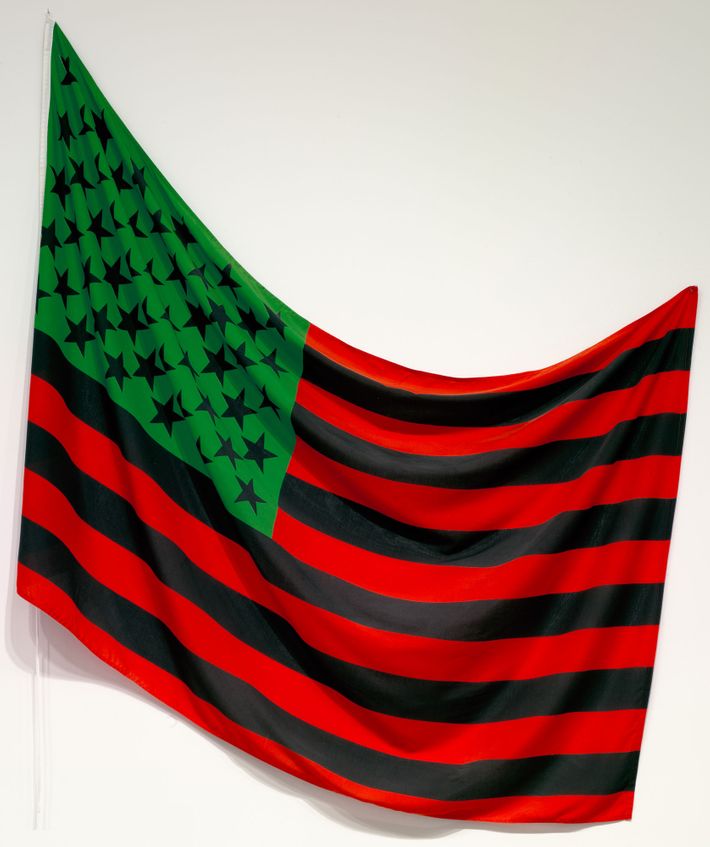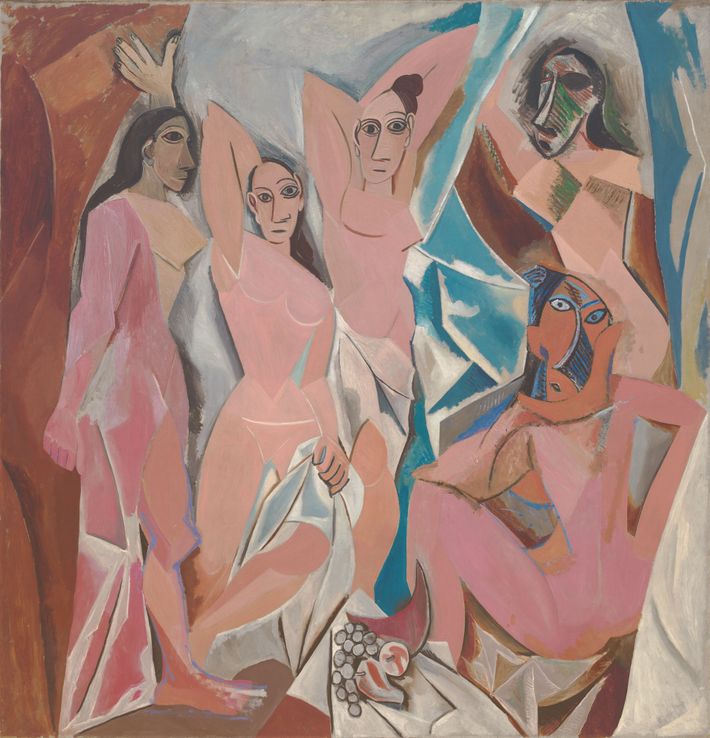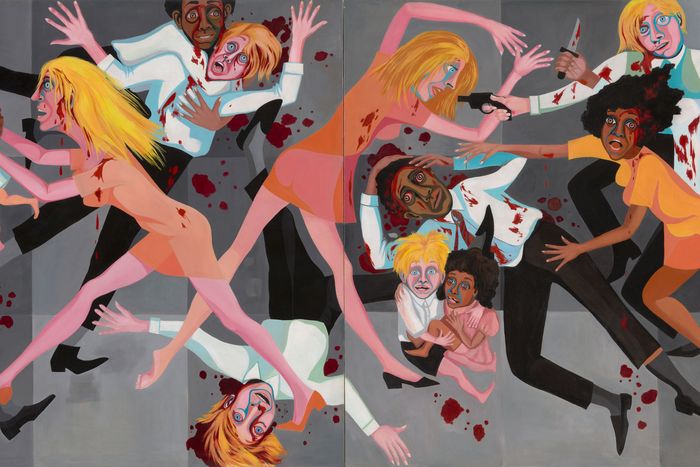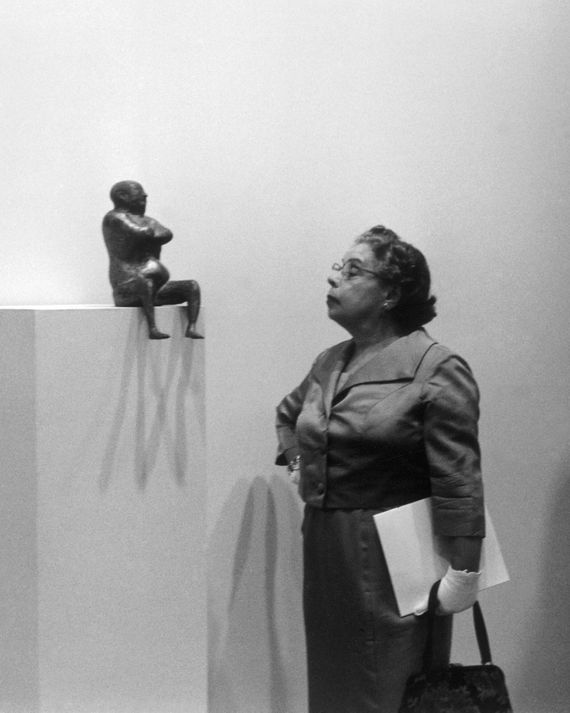
This article was featured in One Great Story, New York’s reading recommendation newsletter. Sign up here to get it nightly.
Can a museum devoted to modernism survive the death of the movement? Can it bring that death about? Ever since the beginnings of the Renaissance in the 14th century, most art movements have lasted one generation, sometimes two. Today, after more than 130 years, modernism is, at least by some measures, insanely and incongruously popular — a world brand. The first thing oligarchs do to signal sophistication, and to cleanse and store money, is collect and build personal museums of modern art, and there’s nothing museumgoers love more than a survey of a mid-century giant. In the U.S., modernism represents the triumph of American greatness and wealth, and it is considered the height of 20th-century European culture — which Americans bought and brought over (which is to say, poached).
Kids sport tattoos of artworks by Gustav Klimt, Henri Matisse, Salvador Dalí, Edvard Munch, Piet Mondrian, and Andy Warhol (you might not think of him as a modernist, but we’ll get to that). Our cities are crowded with glass-walled luxury riffs on high-modernist architecture, the apartments inside full of knockoffs of “mid-century-modern” furniture. Donald Judd’s sleepy minimalist studio outpost in Marfa is now East Hampton in West Texas, a secular pilgrimage site for millionaire collectors, full of expensive restaurants and fancy second homes. As recently as 1994, my wife and I were offered a house there for $5,000.
And people pay — not just for the art, or for environments that call it to mind, but to see the works themselves, even briefly. Witness the Museum of Modern Art’s daily crowds, full-price guests forking over $25. Last year’s annual attendance was just over 3 million (do the math). People take selfies with Starry Night; adolescents feel big feelings because the world didn’t understand Vincent, though they have understood him very well now for well over a century. Movies are made about him and about Pablo Picasso, Paul Gauguin, Frida Kahlo, Jackson Pollock, and Warhol (and the woman who shot him). And Jean-Michel Basquiat — the most recent in the long line of world-straddling geniuses — who died in 1988 at the age of 27. We all know the stories, from destroying one’s own work and committing suicide to womanizing and pissing in fireplaces (in this way, modernism is Hollywood Babylon). And while we take our parents to the Met to appreciate old art, tradition, and “good technique,” we go to MoMA because modernism is cool, still — a sequence of revolutionary gestures, shocks, and succession stories that, we think, tell us something about radicalism and experimentation.
That reputation and those succession dramas are not an accident — they were forged by MoMA in cooperation with artists who very much wanted to see their own work as the natural end point of all art history. (Who wouldn’t?) All this has prevailed since the museum’s founding by wealthy New Yorkers. It opened nine days after the onset of the Great Depression in 1929. Three-quarters of a century after the real peak of modernism, the movement’s grip is like a vise. It is why we are still so captivated by the allure of the avant-garde long after the avant-garde started sleepwalking. And it may be why we still believe artists are like gods long after they began sleeping with money and celebrity. People still quote Duchamp saying, “A painting that doesn’t shock isn’t worth painting.” Why are people still set on shocking their nanas? Modernism. Museums still present all of art history as a long story that breaks, dramatically, with the 20th century. Why? Modernism! Why do I keep asking myself if modernism is over yet? Modernism!
I love modernism — a movement and a culture that can be defined in different ways and often is. I believe, and MoMA has long seemed to assert, that it began with Paul Cézanne’s The Bather (c. 1885). Your starting and end points may vary, but you will surely recognize the formally daring work that defined the first half of the 20th century in Europe and America from school trips and dorm-room walls: Picasso and Matisse, O’Keeffe and Pollock. In many ways, it can still feel truly shocking. Thousands of modernism’s ideas are used by artists today, and I still love many of its artists. All of Picasso, Pollock’s giant drip paintings, and Hilma af Klint’s first forays into the deepest precincts of abstraction take my breath away.
But much of modernism and its concerns now feel long ago, forged in a time of rapid industrial change when white European males assumed they ruled the world. The demands of our times call for something else. And before you object that we’ve been living for 50 years in postmodernism, not modernism, the art that followed the titans of the early-20th century was defined and even named after what preceded it (daddy issues?). What began with Pop and Warhol looked like a break from modernism, but it also extended modernism’s fetishizing of novelty and a canon of iconoclasts. Modernism is part of my life story, all of our life stories, something that shaped the ways we see the world and how the world sees itself. But in the past couple of decades, seismic shifts have occurred, moving us for the first time far beyond the dictates of the movement. Modernism is not headed for the dustbin, but in terms of experimental one-upmanship and the conviction that each new work could break and redefine all of art history, a page is finally turning — slowly, a bit, at least.
This kind of change has happened before, of course — a movement conquering the world, then passing into the past. Usually, it happens much faster. The heyday of tremendous rococo artists like François Boucher, Jean-Honoré Fragonard, and Antoine Watteau lasted just 15 years, at which point neoclassicism deemed it girlie and gauche. Instead, artists like Jacques-Louis David painted gigantic, “masculine” pictures of Roman virtue, the glories of Napoleon, the French Revolution, and mythic deaths — until David was arrested and thrown in prison. Even the High Renaissance came and went in less than 50 years. Impressionism lasted 25 years. By comparison, modernism is, at this point, ancient. Modeling it as something new and cool today would be like the original modernists modeling themselves after the art and values of 130 years before them: Boucher, Jean-Auguste-Dominique Ingres, and Antonio Canova. That modernism has been so canonized is especially ironic given that the earliest modernists were so desperate to break away from the art of the past that they scrapped Renaissance perspective and space. Duchamp wrote that he wanted to use a Rembrandt as an ironing board.
Which raises the question: If modernism wasn’t the end point of art history and the ultimate form of artistic expression, then what was it? If we don’t let it bully its way to the front of the line and center stage, crowding out everything that came before, during, and whatever comes after, what does it look like? And what will it look like as it recedes farther and farther in the rearview mirror and appears not to be the finale of everything that came before but just one more period in a never-ending sequence of them — one set of mannerisms followed by another? As great as many of modernism’s artists are, a lot of this art is about itself, mainly white people arguing about other white people’s art history. Once we’ve left those arguments behind, it may be that the most striking legacy is the cult of the male artist and the competitive aesthetic messianism it spawned.
On October 21, the greatest collection of modern art on the planet will reopen at a new Museum of Modern Art. The newness is not due to a big move to another location or a billion-dollar structure springing up in the old footprint (that last happened in 2004, to so-so reviews), though much of the interior of the iconic — and blandly slick and cramped — building on 53rd Street has been redone and there are new galleries at the base of yet another new MoMA skyscraper full of very expensive condominiums. It is because of what will be presented inside and how.
The museum has traditionally hung its collection chronologically to tell a particular story. The story was: He begat him, who begat him, and so on, until modernism hung a sign on its door that said WE’RE CLOSED (just as countless others showed up at the door). Of course, the story acknowledged, there were rivalries (Matisse vs. Picasso, for instance) and relevant source material and inspiration (again with Picasso). But in general, the story was one of rigid progression that looked, on the museum walls, almost inevitable. Which is exactly as the museum intended: An institution that came of age at the imperial height of the American Century, funded during the Cold War in part with CIA money meant to exalt and export a showcase of free expression (sometimes confused with free enterprise), it wanted viewers very much to believe that modernism was the “ultimate” movement in both senses of the word.
In 1941, MoMA’s great founding director, Alfred Barr, famously drew a diagram of the museum’s ideal permanent collection as a torpedo. (It was while World War II was raging, after all.) The tail is Cézanne, van Gogh, and Seurat. Barr surmised that after 1950, art would come only from America and Mexico. His curatorial successor, Bill Rubin, tripled down on all of it. Except Mexico, of course.
Now the museum is getting rid of the strict timeline. It’s getting rid of movements. Good! Measuring things that way does a disservice to art and to artists — as Willem de Kooning said, “It is disastrous to name ourselves.” MoMA will be hanging works from different eras, and different places, next to one another, opening up what had begun to seem like an airless, self-referential canon into something much more dynamic. The museum is even discarding its 89-year aversion to showing different mediums together. As a geezer, I relish back-to-back galleries of killer paintings, but it’s fitting to stop showing art in only this way, in part because the new strategy allows us to go back and ask new questions of work we thought we understood, and in part because it’s how artists themselves see art history, today especially — not as a timeline of progress but as a beautiful trash heap or costume shop in which to play. (In the age of the internet, with a globalized art world and the breaking down of at least some barriers to entry, this probably isn’t too surprising.)
Most exciting of all, MoMA’s permanent collection will no longer be a static thing. Every six months, a third of it will be reinstalled. I presume the twin peaks of Picasso and Matisse will always be on display somewhere along with other trophy works and big names. But there will be many more names, too, belonging to people less well known, less than a century old, less white, less male, and less exclusively American and European. This means that every 18 months, MoMA will be entirely new. If you’re irked with the way the collection looks now, come back in six months — you never know. Good-bye, canon! At least the static, eternal, Old Testament teleological one we all grew up with. In 2004, when MoMA reopened in a then-new glass-and-steel campus, only 5 percent of the art on view in the permanent collection was by women. Today, the museum estimates that 28 percent of the works on view are by women, and 21 percent by artists outside of Western Europe, the U.S., and Canada — that’s gigantic for MoMA, modernism, and art.
“This past five to ten years is the most change-making, radical rethinking of art history and, by extension, museum curation in a half-century,” said Ann Temkin, the chief curator of painting and sculpture, in a lecture. “Things that were assumed over the last 40, 20, ten, or even five years have exploded.” Amen.
So — what was assumed? Let’s look at five big things.
First, there was Ezra Pound’s cri de coeur “Make it new.” In modernism, only newness was given value. Everything old was considered passé, inadequate to address the times, which meant modernism claimed not just a monopoly on newness but also on importance. One Dadaist said, “Art is dead.” Case closed.Of course, all art was once new. Cave painters painted over older cave paintings; Roman pots sport artist signatures like “No one could ever make a grain pot as good as this.” It’s the same way each generation thinks it has invented sex; newness is as old as time. The modernists were just a lot cockier about saying so.
Second, modernism called itself reality. Which meant, perversely, it didn’t have to bother to address or depict actual reality — instead, it offered itself as the only thing that mattered. Kandinsky wrote, “Realism = Abstraction. Abstraction = Realism.” American critic Clement Greenberg said art was meant to “undeceive the eye.” Much modern art turned away from the world and into itself while denying subject matter and narrative altogether. At least the importance of subject matter, since much modernism employed traditional (not “new,” hello!) subject matter: nudes, landscapes, still lifes, more nudes, everyday scenes, nature, architecture, and more nudes. What an artist had to render new was how these things looked. Viewers were expected to look through subject matter. You weren’t seeing a landscape; you saw how this artist reinvented the landscape. By the end of the 20th century, Gerhard Richter even said he was “indifferent” to subject matter (he painted Nazis, terrorists, and 9/11, of course). Much of this means the world modernism gives you is the world of the artist’s studio—and optical shoptalk. This is what allowed artists to make squiggles, squares, rectangles, pictures of violins, color arrangements, street scenes, and naked ladies even during the carnage of World War I and World War II. By the time I was trying (and failing) to enter the art world in the 1970s, painting was supposed to be only about itself, its materials, and “flatness.”
Third, modernism was built on the principle that formal experimentation is the only thing that matters. The doctrine can’t be emphasized enough. Every artist had to create his [sic] own forms and world. These forms had to follow visual strictures: Art had to be seen all at once, not sequentially or with any formal hierarchy. (That meant it couldn’t have narrative.) Think of how you see all of a Pollock at once, even though it has parts and details. Similarly, you weren’t supposed to be able to separate process and material, just as we see medieval mosaics as image, color, surface, process, and material all at the same time and as one thing. Modernism was philosophically colonialist this way and loved declaring everything as its own, all while asserting it was inventing even those things it was stealing.
Fourth, there was the principle that modern art would “kill history” — a hysteria of finality. Modernism was born in the immediate wake of and during multiple revolutions, mass industrialization, and colonial empires, and inventions like photography, movies, flight, automobiles, X-rays, and Einstein’s theory of relativity. Duchamp said painting should “avoid all contact with traditional” art. In wanting to destroy the whole history of Western art, modernists were like an aesthetic Taliban. Except for the art they approved of, everything else was deemed bourgeois, Establishment, bad taste, or kitsch.
When Americans took up the mantle with Abstract Expressionism, they were no less absolutist. They had not seen their previous culture destroyed by war, but they were still modernists. Barnett Newman said American artists had to “start from scratch.” Ad Reinhardt said, “I am merely making the last painting which anyone can make.” History didn’t exist unless you were making it. (It’s always the end-times again in modernism.)
Fifth, there was modernism’s grand teleology — the whack-rationalist idea that history was to proceed in a predefined order. If you didn’t fit, know, or care, or were a visionary, an artist of color, or female, tough luck. Only the things in its timeline were deemed progress. Progress was to be the goal of all art.
For those actually living modernism, though, the whole project was way messier and more rivalrous than could ever be reduced to any set of principles. After all, before MoMA got its hand on modernism, it wasn’t propaganda. It was just art. Which means: It was a lot of different, competing propagandas.
In fact, modernism was more like a wrestling match of competing egos vying for top-dog status, each saying he’d replaced or repudiated the previous one. Picasso was against abstraction. (What a pill!) Mondrian wrote, “Cubism did not accept the logical consequences of its own discoveries.” His goal? “Pure plastics.” (I’m still not sure what this means.) Russian Suprematist high priest Kazimir Malevich demanded “victory over the sun” and “the supremacy of pure feeling.” (What?) In 1912, Duchamp said, “Painting is over.” In 1921, Constructivist Aleksandr Rodchenko said, “I have reduced painting to its logical conclusion … I affirmed it’s all over.” (Hello, Doctor Death.) Duchamp did, however, muse, “Can one make works of art that are not ‘works’ of art?” (I love that!) Then Greenberg called Duchamp “sub-art.” What a bully!
The “Pope of Surrealism,” André Breton, “excommunicated” heretics like Alberto Giacometti and, in 1934, put Dalí “on trial.” (God complexes and control freaks are a modernist feature, not a glitch.) Minimalist Judd opined that with the “readymade,” Duchamp had invented fire but didn’t do enough with it. Much later, Duchamp said contemporary artists “no longer make pictures; they make checks.” Soon Chris Burden and Richard Prince made art out of checks. Now artists make art out of Prince.
Things have come a long way since the Armory Show of 1913 — that’s the true genesis of all that might be called modern art in America and the first in-depth look Americans got at European modernism. In New York, 85,000 people attended; in Chicago, attendance was 188,000. American salon impresario Mabel Dodge wrote to Gertrude Stein that in New York, the show was “the most important public event … since the signing of the Declaration of Independence” and added that “things will never be the same afterwards.” She was right. One New York critic wrote, “American artists did not so much visit the exhibition as live at it.” Albert Barnes, Henry Frick, and the Met bought works. It’s no exaggeration to say the founding of MoMA stems from those 27 earthshaking days in New York.
At the time, the impact could be measured most by the resistance. Traditionalists protested that the show was like “visiting a lunatic asylum.” Matisse was burned in effigy. Teddy Roosevelt said the art was “repellent from every standpoint” and asserted there was “no reason why people should not call themselves Cubists, or Octagonists, or Parallelopipedonists, or Knights of the Isosceles Triangle … one term is as fatuous as another.” Duchamp’s Nude Descending a Staircase, No. 2 was the most scandalous work in the show. In newspapers, it was derided as Rush Hour in the Subway and Explosion in a Shingle Factory.
That the masses might mock avant-garde art is so familiar today it’s hard to believe no one had bothered to do it before modernism (though it had happened in the rarefied air of the French and English salons). But why would anyone have bothered before? Until modernism, no art movement had ever made anything as totalizing and threatening as the proposition modernism did: that art would remake the world.
It did, and it didn’t. First, in America modernism would have to be reimagined. By 1948, Newman was painting stripes and monochromatic fields of bright color on large canvases. Pollock began to drip in 1947. Émigrée Peggy Guggenheim opened the Art of This Century Gallery, exhibiting both European modernists and starving, struggling Americans, among them Clyfford Still, William Baziotes, Alexander Calder, Adolph Gottlieb, Joseph Cornell, Robert Motherwell, de Kooning, and Mark Rothko. She gave Pollock his first solo show in 1943. A new game was in the offing: America claiming the European avant-garde as its own imperial patrimony.
The values of Abstract Expressionism included enormous scale, the male painter alone in the arena painting in pursuit of total abstraction (except for de Kooning — who Pollock said “betrayed it”). These artists embraced myth, the sublime, transcendence, existential and spiritual terror, cosmic light and darkness, and all that hocus-pocus. And celebrity. Soon, Pollock was featured in Life magazine in the act of painting and smoking. All looked rosy.
Abstract Expressionism restarted modernism wonderfully, but the movement quickly died another death. In 1953, 27-year-old Robert Rauschenberg arrived at de Kooning’s studio with a bottle of liquor in trade for a drawing he said he’d erase. De Kooning’s best biographers, Mark Stevens and Annalyn Swan, call this rendezvous “a ghostly Greek messenger come to warn the king of hubris.” De Kooning said, “I know what you’re doing,” and granted the request.
That same year, Rauschenberg and composer-artist John Cage made Automobile Tire Print, a long, narrow strip of paper on which Cage had driven a car, leaving a long track in black ink. All this was a direct attack on the life-or-death gravitas of Abstract Expressionism — and indeed all of modernism. Art would soon be riven with irony, something that had left it for some time. These ironies multiplied all over the world for the next decades. In 1956, the first Pop Art show took place in London. In Europe, Yves Klein and Piero Manzoni were ascendant. 1957 brought the most political international postwar art movement of them all: Situationism, which railed against personality-based individualism and asserted that art is determined by real-world conditions and situations. Artists today still work from that premise.
The coup de grâce came on January 1, 1958. Target With Four Faces garnered the cover of the No. 1 art magazine of the time, ArtNews. The work was by 27-year-old unknown Jasper Johns. Three weeks later, this change lurched into hyperspeed when Johns’s debut solo show opened at Leo Castelli’s new fourth-floor gallery at 4 East 77th Street, and American art turned on a dime. MoMA acquired three works from the show and arranged for a fourth, Flag (for $900), to be purchased as a gift for the museum. All are now modernist icons. A new world was released.
And while many of the younger artists were still white and male, something nevertheless new came to the fore: Many of them were gay. All held views diametrically opposed to the lofty art values they’d been schooled in.
They painted smaller, figuratively, employed subject matter non-spontaneously, were uninterested in spiritualism or strict formal things like “flatness,” the sublime, or cathedrals of selves, and even violated the sacrosanct surfaces of their art by attaching real objects to them. (Ed Ruscha and Robert Indiana painted paintings of words.) Like all artists after them, they were formalist and anti-formalist, sincere and ironic, at the same time. (The latter is a condition of life.) These artists didn’t turn away from but embraced the mass culture around them. They brought life back into art. All of it was intentional. Rauschenberg said he and Johns “used to start each day by having to move out from Abstract Expressionism.”
These innovations were important, of course. Yet in attacking their modernist forebears, the Pop artists were also affirming the reign of their ideology. In 1961, Robert Smithson wrote, “I am a Modern artist dying of Modernism.” He was right. Pop Art and minimalism were derived from mass taste, sources, and material and were ironic, but they were also committed to making it new, to the idea of the work of art as a closed perfect space, to formal experimentation and innovation above all else, to repudiating previous art history, and to the conception of art as a teleological project. And, of course, it shocked your nana.
What will it be like to live without the old modernist canon? I expect thrilling and scary. I don’t want Picasso and the rest to go away. And of course they won’t — we can’t forget these titans, even as we rehang and reconsider their work every year.
But here’s how art has already moved on. Modernism is now just part of art history to artists, and not even the only or best part. Artists are ranging through history, happy to make things new by returning to older unused, overlooked art. I’ve seen countless artists deploy Cubism and Post-Impressionism in ways that make the Ur-modernist movements just another segment of the aesthetic double helix. Artists like Jenna Gribbon, Louis Fratino, Carroll Dunham, Sarah Peters, and Jonathan Lyndon Chase actually cross the beams of modernism with motives on Greek vases. And it’s not pastiche or gamesmanship. Kerry James Marshall goes all the way back to neoclassical history painting to tell new stories picturing black bodies rather than white heroes.
Subject matter and narrative rise in art everywhere. With a hungry, documenting eye as lucid as Walker Evans’s and Robert Frank’s, photographer LaToya Ruby Frazier photographs working-class American cities and people decimated by toxic environments and jerry-rigged governmental policy. Is her work “didactic”? It is! In the works of numerous artists, collectives, and collaborations, we’re seeing brilliant portrayals of institutional cruelty. In other words, the real world—and not just as it’s reflected in the artist’s studio. You don’t need a wall label to feel the gut punch. Ditto the set-up photographs of queer quadriplegic Robert Andy Coombs that shows the artist as explicitly sexual with agency and desire. Christine Sun Kim retrofits the charts of strict minimalism and conceptualism to express the rage of her own deaf community.
Modernism began in many places at different times. Today, artists aren’t robbing or trying to kill the past. They’re collaborating with it. Instead of only formal experimentation, subject matter and other imaginations have arrived as the electric center of artistic innovation — narrative, biography, autobiography, history, cultural context, and family trees, all long dismissed as unserious or provincial concerns, have been injected into art. The purities of modernism don’t mean a thing; recent minimalist, monochrome, conceptual art about art feels like artists being junior postmodernists. We may look at them and pass on. Art no longer seems locked in a competitive struggle for artistic supremacy. Except in the market, where it has always been this way.
But the monolith of modernism is gone. Artists aren’t just crawling into the skins of former styles. They’re consuming, using, changing, and cannibalizing them. Gone is any bullying certainty. We see subjectivity, something like ethics, responsibility, the social contract, personal obsession, and earnest attempts to communicate again with less insider-y audiences. Rather than plotting where this art fits on the teleological-formalist timeline, consider Romanesque and medieval church façades: These masterpieces tell essential stories in visually sophisticated, visionary ways, all with an extraordinary use of material, scale, ambition, everything, yet anyone may experience, read, grasp, and be part of this art. They are open books. These are the connotations and possibilities of art now. Art has landed on another moon.
Where does this leave MoMA? Alas, I am not a radical, so I am glad the museum won’t be changing that much. I do not want to destroy MoMA or other museums of modernism (flawed as they are). I still need to return there regularly to commune with the ancestors. Others will don the mantle of fixing and replacing the entire system. If MoMA has a radical love of art rather than a love of the underlying system, it will play a part in the generations to come — and it may be that future art historians point to this rehanging as a turning point, the central institution of modernism committing to a new set of ideas about what it was, what it represents, and what it offers us today. I say to MoMA, bring out your dead from storage, artists deemed “wrong,” not part of the old story — put them all on view, let us decide. We all love art. But as James Baldwin wrote, “Love is a battle … love is growing up.” After a century, we are finally beginning to outgrow modernism.
MoMA Remixed
The new MoMA will get rid of its strict timelines, its airless taxonomy of movements, and hang works from different eras, and different places, next to one another, in conversation. One art critic’s suggested pairings …
Henri Matisse With Chris Ofili
Jackson Pollock With Julie Mehretu
Jasper Johns With David Hammons
Pablo Picasso With Faith Ringgold
*This article appears in the September 30, 2019, issue of New York Magazine. Subscribe Now!


